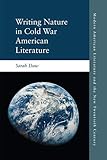Writing Nature in Cold War American Literature / Sarah Daw.
Material type: TextSeries: Modern American Literature and the New Twentieth Century : MALN20CPublisher: Edinburgh : Edinburgh University Press, [2022]Copyright date: ©2018Description: 1 online resource (264 p.)Content type:
TextSeries: Modern American Literature and the New Twentieth Century : MALN20CPublisher: Edinburgh : Edinburgh University Press, [2022]Copyright date: ©2018Description: 1 online resource (264 p.)Content type: - 9781474430043
- 801/.95
- PN98.E36 D39 2018
- online - DeGruyter
| Item type | Current library | Call number | URL | Status | Notes | Barcode | |
|---|---|---|---|---|---|---|---|
 eBook
eBook
|
Biblioteca "Angelicum" Pont. Univ. S.Tommaso d'Aquino Nuvola online | online - DeGruyter (Browse shelf(Opens below)) | Online access | Not for loan (Accesso limitato) | Accesso per gli utenti autorizzati / Access for authorized users | (dgr)9781474430043 |
Frontmatter -- CONTENTS -- ACKNOWLEDGEMENTS -- Introduction: Ecocriticism and the Mid-Twentieth Century -- 1 Attaining fana in Paul Bowles’s Infinite Landscapes -- 2 Nature and the Nuclear Southwest: Peggy Pond Church and J. Robert Oppenheimer -- 3 The Influence of Chinese and Japanese Literature on J. D. Salinger’s Philosophy of Nature -- 4 The Beat Ecologies of Allen Ginsberg and Jack Kerouac -- 5 Bifurcated Nature in Mary McCarthy’s Birds of America -- Conclusion: ‘Know that the earth will madonna the Bomb’ -- NOTES -- INDEX
restricted access online access with authorization star
http://purl.org/coar/access_right/c_16ec
First book-length ecocritical study of Cold War American literatureCompelling analyses of the function and representation of Nature in a wide range of Cold War fiction and poetry by authors including Paul Bowles, J. D. Salinger, Jack Kerouac, Allen Ginsberg and Mary McCarthy reveals the prevalence of portrayals of Nature as an infinite, interdependent system in American literature written between 1945 and 1971.Daw astutely highlights the Cold War’s often overlooked role in environmental history and argues that Rachel Carson’s Silent Spring (1962) can be considered as part of a trend of increasingly ecological depictions of Nature in literature written after 1945. By exploring the most recent developments in the field of ecocriticism, the book is embedded within current ecocritical debates concerning the Anthropocene and anthropogenic climate change.Key FeaturesContains five case studies of six Cold War writers: Paul Bowles, Peggy Pond Church, J. D. Salinger, Jack Kerouac, Allen Ginsberg and Mary McCarthyOffers an in-depth exploration of the influences behind each writer’s presentation of NatureShows the Cold War to be a time of seismic change in the human’s relationship to the environment, and demonstrates the degree to which this inflects Cold War literatureEngages with the most recent developments in the field of ecocriticism, which drive the study’s analytical methodology and embed the book within current ecocritical debates
Mode of access: Internet via World Wide Web.
In English.
Description based on online resource; title from PDF title page (publisher's Web site, viewed 29. Jun 2022)


